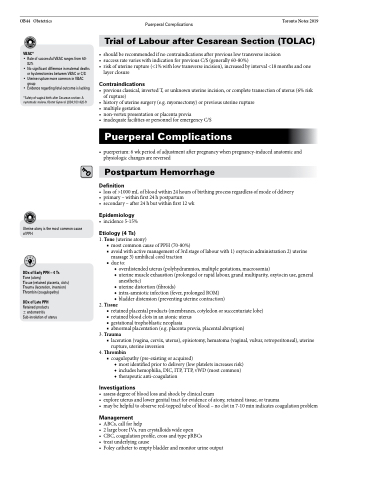Page 884 - TNFlipTest
P. 884
OB44 Obstetrics
VBAC*
• Rate of successful VBAC ranges from 60- 82%
• No significant difference in maternal deaths or hysterectomies between VBAC or C/S
• Uterine rupture more common in VBAC group
• Evidence regarding fetal outcome is lacking *Safety of vaginal birth after Cesarean section: A
systematic review. Obstet Gynecol 2004;103:420-9
Puerperal Complications Toronto Notes 2019 Trial of Labour after Cesarean Section (TOLAC)
• shouldberecommendedifnocontraindicationsafterpreviouslowtransverseincision
• successratevarieswithindicationforpreviousC/S(generally60-80%)
• riskofuterinerupture(<1%withlowtransverseincision),increasedbyinterval<18monthsandone
layer closure
Contraindications
• previousclassical,invertedT,orunknownuterineincision,orcompletetransectionofuterus(6%risk of rupture)
• history of uterine surgery (e.g. myomectomy) or previous uterine rupture • multiplegestation
• non-vertexpresentationorplacentaprevia
• inadequatefacilitiesorpersonnelforemergencyC/S
Puerperal Complications
• puerperium:6wkperiodofadjustmentafterpregnancywhenpregnancy-inducedanatomicand physiologic changes are reversed
Postpartum Hemorrhage
Definition
• lossof>1000mLofbloodwithin24hoursofbirthingprocessregardlessofmodeofdelivery • primary–withinfirst24hpostpartum
• secondary–after24hbutwithinfirst12wk
Epidemiology
• incidence5-15%
Etiology (4 Ts)
1. Tone (uterine atony)
■ most common cause of PPH (70-80%)
■ avoid with active management of 3rd stage of labour with 1) oxytocin administration 2) uterine
massage 3) umbilical cord traction ■ due to:
◆ overdistended uterus (polyhydramnios, multiple gestations, macrosomia)
◆ uterine muscle exhaustion (prolonged or rapid labour, grand multiparity, oxytocin use, general
anesthetic)
◆ uterine distortion (fibroids)
◆ intra-amniotic infection (fever, prolonged ROM)
◆ bladder distension (preventing uterine contraction)
2. Tissue
■ retained placental products (membranes, cotyledon or succenturiate lobe) ■ retained blood clots in an atonic uterus
■ gestational trophoblastic neoplasia
■ abnormal placentation (e.g. placenta previa, placental abruption)
3. Trauma
■ laceration (vagina, cervix, uterus), episiotomy, hematoma (vaginal, vulvar, retroperitoneal), uterine
rupture, uterine inversion 4. Thrombin
■ coagulopathy (pre-existing or acquired)
◆ most identified prior to delivery (low platelets increases risk) ◆ includes hemophilia, DIC, ITP, TTP, vWD (most common) ◆ therapeutic anti-coagulation
Investigations
• assessdegreeofbloodlossandshockbyclinicalexam
• exploreuterusandlowergenitaltractforevidenceofatony,retainedtissue,ortrauma
• maybehelpfultoobservered-toppedtubeofblood–noclotin7-10minindicatescoagulationproblem
Management
• ABCs,callforhelp
• 2largeboreIVs,runcrystalloidswideopen
• CBC,coagulationprofile,crossandtypepRBCs
• treatunderlyingcause
• Foleycathetertoemptybladderandmonitorurineoutput
Uterine atony is the most common cause of PPH
DDxofEarlyPPH–4Ts
Tone (atony)
Tissue (retained placenta, clots) Trauma (laceration, inversion) Thrombin (coagulopathy)
DDx of Late PPH
Retained products
± endometritis Sub-involution of uterus


